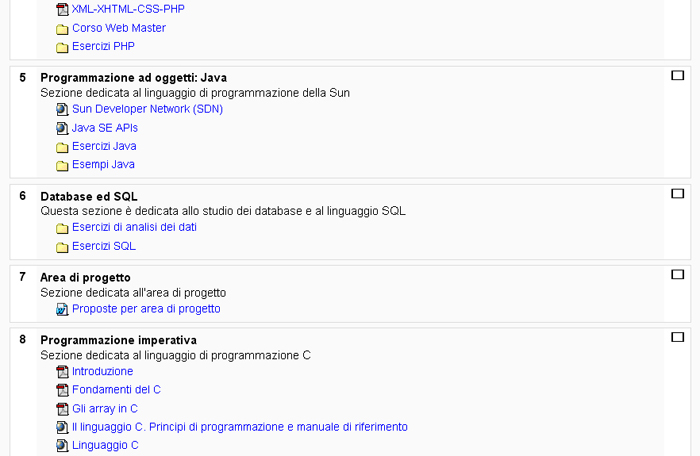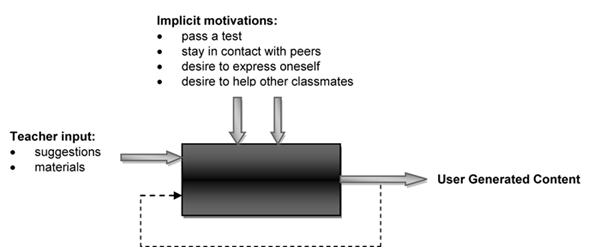User generated content: a new way to mix the role of teacher and student
Contents
Abstract
During the last years the use of the Web changed a lot, influencing also educational institutions. Despite that, it is not possible to observe a real change in school, where teachers remain the main actors of daily class activities, even if, outside the class, a great amount of resources are created and shared by students, showing the desire to become the main protagonists of their learning. To better illustrate this phenomenon an experience from secondary school is described, underling the importance for teachers to change their traditional teaching practices.
Introduction
During the last years the use of the Web changed a lot: from simple read-only system, with the presence of few authors and a lot of readers, now it becomes a more collaborative environment, where the most important aspect is interact with other users, generate new personal contents and share them with friends and peers. Nowadays we talk about “prosumers” (http://en.wikipedia.org/wiki/Prosumer), users of the Web that are at the same time producers and consumers of resources.
This new face of the Web, called Web 2.0, and in particular the idea of an open Web, has an important impact in education (OPAL, 2011), not only facilitating the connection between teachers, learners and institutions, but also facilitating the creation and sharing of new educational resources interacting in open environments. This brought to the definition of OER (Open Educational Resources) (http://en.wikipedia.org/wiki/Open_educational_resources) and of OEP (Open Educational Practices), i.e., the possibility to freely use educational resources in open learning environments (OPAL 2011).
If from one side this great amount of resources offers a new important opportunity of learning to people that have difficulties to access to resources of high quality, from another side facilitates the re-use, remix and share of new resources by the same users that access to materials.
This brings to a new concept, i.e. the idea of user-generated content (UGC). This term is used to describe all the contents created by users outside of professional routines and practices, without an institutional or a commercial market context, and published online (OECD, 2007).
Despite this material is often difficult to find, it can have an important impact in the changing role of teachers and learners, and in particular in teacher professional practices. To better describe the impact of UGC in practices and its informal nature, a real example will be illustrated in the follows section.
UGC: an example from secondary school
In this section is described an experience with UGC that I recognized during the last school year, working with my students. The educational level is upper secondary schools and the pupils, from 17 to 18 years old, are studying informatics in a vocational institution.
Since I had decided to avoid to adopt a book to teach my subject, to provide educational materials to my students I deployed a Moodle platform (see image below, URL: http://www.projectschool.it). Every students had the possibility to login into the platform and download files concerning specific topics and also my lecture notes.
Safe to provide a good service to my pupils, I was surprised about two things: the interactions into forums that I had activated online decreased month after month, as well as the accesses to the platform. Despite that, the results of students’ assessments were not decreased.
The reason for this lack of interest for my online platform it was clear when, walking through the class, I discovered one of my pupils to study on particular notes that were not mine. Since the material was good I asked him where he downloaded the file, for sharing it with the whole class, but my student surprised me saying that the file was created by the class, mixing my notes and other digital objects, and that it was possible to download it from an online forum.
This finding surprised me for many reasons: the difficulty to involve my students in extra school activities, the necessity of another environment, different from the one offered by me, and the absence of an explicit incentive to create this resource, only the need to pass a test, to stay in contact with peer and maybe the desire, from some students, to express themselves and help other classmates.
This example of UGC, not planned by the teacher, highlights the difficulty to find out these materials, and their informal nature, outside the institutional environments, as well as the difficulty to evaluate the authors of these contents. Another important aspect is the collaborative form of creation of these resources, that did not involve a single student but a community of users, aspect that brings to define these materials like User-Co-Generated Content (UCGC).
A new relation between teacher and students
This experience, even if related to a single case and to a specific subject like informatics, it is interesting to reflect about the role of teacher and students and the new relation between them, in particular in secondary school.
As mentioned in the first section, during the last years the Web changed its nature, from a read-only system, with few authors and a lot of consumers, to a collaborative environment, where the role of author and reader are mixed together. Despite the impact of the Web in learning, we can detect that our classes remained class Web 1.0, with few teachers that deliver contents, and a lot of users, the students, that read these materials. Despite new technologies entered in our classes (like interactive whiteboard), and despite a lot of efforts for training teachers in using ICT, there are only few examples of a real change in teachers’ practices. The teachers keep on being the main actors and producers into a class: many times the teachers complain saying: “we work more than our students”, and this sentence demonstrates not only the teachers' discomfort, but also the impossibility to see new solutions, new practices, and in particular the difficulty to see like the students are already changing their way to learn, with the risk to have teachers 1.0 with students 2.0.
It is possible to justify this situation in different ways: teachers are not properly trained to address the new challenges of the information society, students are digital native, so more inclined towards new technologies than teachers, but the main issue remains: it is necessary to involve students like authors of their learning activities, the teacher has to come down from the teaching post, to better observe the dynamics among students and facilitate the creating of new contents.
The example previously described demonstrates like the students are able to become protagonists of their learning also without a strong presence of the teacher, that only has to support them.
The experience described in the previous section also underlines the informal nature of UGC and the difficulty to follow the collaborative process of creation of these materials (for some teachers this process remains a black box, see image above), as well as the difficulty to evaluate the authors of these contents. A solution for this last issue could be involve students in the evaluation phase, where teachers, and in particular their educational resources, are part of the elements to be evaluated. Again, we are mixing the role of teacher and students, in a perspective of class 2.0, where the teaching post is eliminated or shared between teacher and pupils, and the students’ motivation sustained making them protagonists of their learning
References
- OPAL (2011). OEP Guidelines for Learners, URL: http://oer-quality.org/, last visited July 2011.
- OECD (2007). Participative Web: User-Created Content, March 2007, URL: http://www.oecd.org/dataoecd/57/14/38393115.pdf

